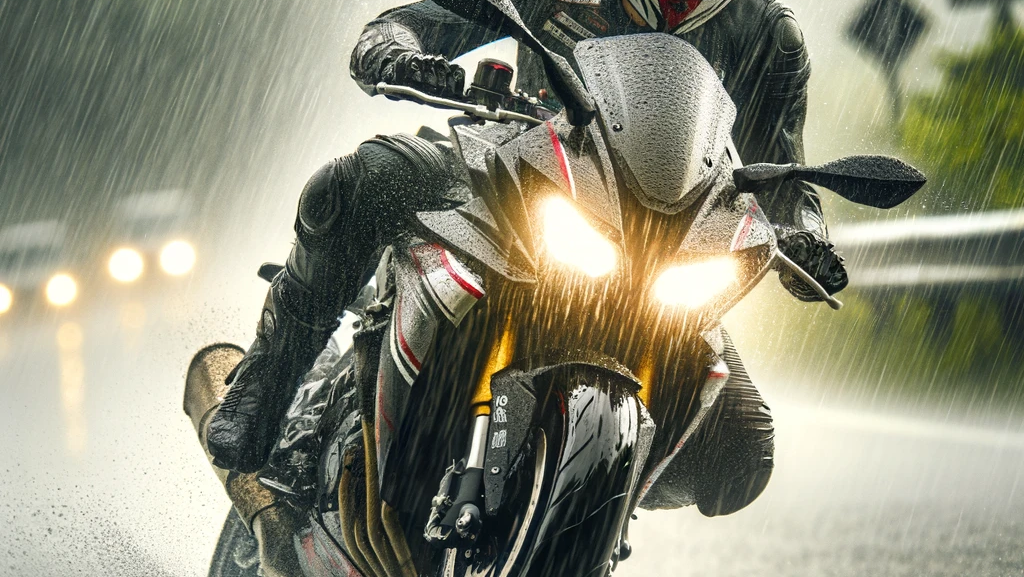Riding a motorcycle in the rain isn’t everyone’s idea of a good time, but sometimes, it’s unavoidable. Whether you’re caught in an unexpected downpour or just love the thrill of a rainy ride, knowing how to handle your bike in wet conditions is crucial. In this blog, we’ll explore essential tips and strategies to keep you safe and confident on rainy roads.
Choosing the Right Gear
First things first: gear up! The right equipment can make a world of difference when riding in the rain. Here’s what you need:
- Waterproof Jacket and Pants: Invest in high-quality, waterproof gear to keep you dry and warm. Look for materials that offer breathability as well.
- Helmet with Anti-Fog Visor: Visibility is crucial. An anti-fog visor will help you see clearly, even in the wettest conditions.
- Waterproof Gloves and Boots: Keep your hands and feet dry to maintain control of your bike. Waterproof gloves with good grip and insulated boots are a must.
- Reflective Gear: Rain reduces visibility, so make sure you’re easily seen by other drivers. Reflective strips or bright colors can help.
Preparing Your Motorcycle
Before hitting the road, ensure your motorcycle is ready for wet conditions. Here’s what to check:
- Tires: Make sure your tires have enough tread and are properly inflated. Good tread helps channel water away and maintain grip.
- Brakes: Wet brakes can be less effective. Test them before you start your ride and ensure they’re responsive.
- Lights: Check that all your lights are working. Visibility can be severely reduced in the rain, so functioning headlights, taillights, and indicators are essential.
- Chain Maintenance: A well-lubricated chain is less likely to slip in wet conditions.
Riding Techniques for Wet Roads
Now that you’re geared up and your bike is ready, let’s talk about riding techniques. Here are some tips to keep in mind:
- Smooth Inputs: Be gentle with your throttle, brakes, and steering. Abrupt movements can cause your tires to lose grip.
- Increase Following Distance: Wet roads mean longer stopping distances. Give yourself plenty of space to react to traffic changes.
- Avoid Puddles: You never know what’s lurking beneath a puddle. Avoid them to prevent potential hazards like potholes or slippery oil patches.
- Stay Upright: Leaning too much can reduce your tires’ contact with the road. Try to keep your bike more upright when cornering.
- Use Engine Braking: Instead of relying solely on your brakes, use your engine to help slow down. This can prevent skidding.
Dealing with Common Challenges
Riding in the rain brings unique challenges. Here’s how to tackle a few of them:
- Hydroplaning: This happens when a layer of water builds up between your tires and the road. If you feel your bike starting to hydroplane, gently ease off the throttle and avoid sudden movements until you regain traction.
- Visibility: Rain can drastically reduce visibility. Use your bike’s lights, wear reflective gear, and keep a safe distance from other vehicles.
- Cold and Wet: Staying warm is crucial for maintaining concentration and reaction times. Wear layered clothing and consider heated grips or seats.
Post-Ride Maintenance
After your rainy ride, a bit of maintenance can prevent long-term damage to your motorcycle:
- Dry Your Bike: Wipe down your bike to prevent rust and corrosion. Pay special attention to the chain and brake components.
- Lubricate the Chain: Wet conditions can strip lubrication from your chain. Apply a fresh coat to keep it running smoothly.
- Check Your Gear: Dry out your gear thoroughly before your next ride to prevent mold and mildew.

